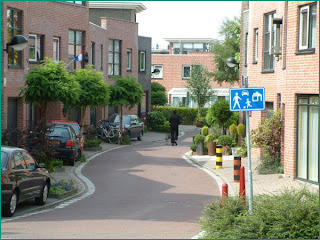The concept of the Woonerf
began in the 1960s with the Dutch architect Niek De Boer who wanted to correct two
problems in city streets: inconvenient traffic flows as well as decaying streetscapes. A Woonerf
functions as a play street for children as well as a cut through to larger
streets while reducing the flow of traffic and forcing drivers to be aware of
their surroundings. Characteristics of a Woonerf are
distinct gateways, benches, plants, play equipment, and parking with
intermittent spacing. The key distinction of a woonerf is
the elimination of continuous curbs, placing the car and the the pedestrian on
the same level. The benches, trees, and plants serve to direct the car through the street. A woonerf is typically marked by a blue sign with a picture of a pedestrian, a child playing, a house, and a car.
On July 18, 2011, I observed a Woonerf in
action on Frederikstraat,
about a fifteen minute walk from the Arco Hotel. Initially, I thought cars and
pedestrians sharing a single street would prove to be difficult and result in
injured pedestrians and frustrated drivers. I observed from 2:15 to 3:00 pm.
I observed twenty-four bikers passing through the Woonerf
within the hour, mostly on leisurely rides or running errands. Fifteen
cars drove through, all aware of bikers and driving very slowly. Thirty
one pedestrians walked along the street, mostly mothers with small
children and older couples who appeared to be tourists. Also many
children ran through the street when no cars were around, and no accidents occurred.
The Woonerf in
Amsterdam had a very pleasant, relaxed atmosphere. Many pedestrians were
lounging on the sidewalk, like the man above. Overall, no one seemed to be
worried about getting hit by a car, and several small children were able to
roam the streets freely.
Woonerfs are
an innovative urban design feature that effectively reduce traffic flow in
residential sectors of cities and towns. They physically raise
the pedestrian to the same level as the automobile, empowering
those who choose alternative modes of transportation. It eliminates excessive
traffic noise and speed, and creates community gathering spaces. A few
drawbacks are the costs of renovating these streets, as well as the constants
maintenance required to keep the street in good condition. Also, although
traffic is thinned out on one street, the mass of transit will simply move
elsewhere. Nevertheless, Woonerfs are a step in the right direction
and can be improved with increased community involvement.
-Annalise Reichert




No comments:
Post a Comment